Leadership Dynamics Report: Organisational and Environmental Factors
VerifiedAdded on 2023/04/21
|16
|5247
|428
Report
AI Summary
This report delves into the multifaceted aspects of leadership dynamics, examining various methods and techniques used to measure leadership success, including evaluation feedback, external audits, business results, and customer assessments. It explores the concept of leadership values, emphasizing their significance in guiding leaders' decisions and fostering positive impacts. The report assesses how leaders influence follower motivation through various strategies, such as leading by example and providing feedback, and how they impact follower satisfaction by addressing hygiene and motivational factors. Furthermore, it analyzes the dynamic relationship between motivation, satisfaction, and performance, highlighting the importance of understanding and implementing policies to positively influence these factors. The report also examines the role of leadership as a group and team function, along with the influence of organizational factors like culture and structure. Finally, it evaluates the impact of legal, political, and economic environments on leadership and explores emotional approaches to organizational change, providing real-world examples to illustrate the concepts discussed.

Leadership Dynamics
Paraphrase This Document
Need a fresh take? Get an instant paraphrase of this document with our AI Paraphraser
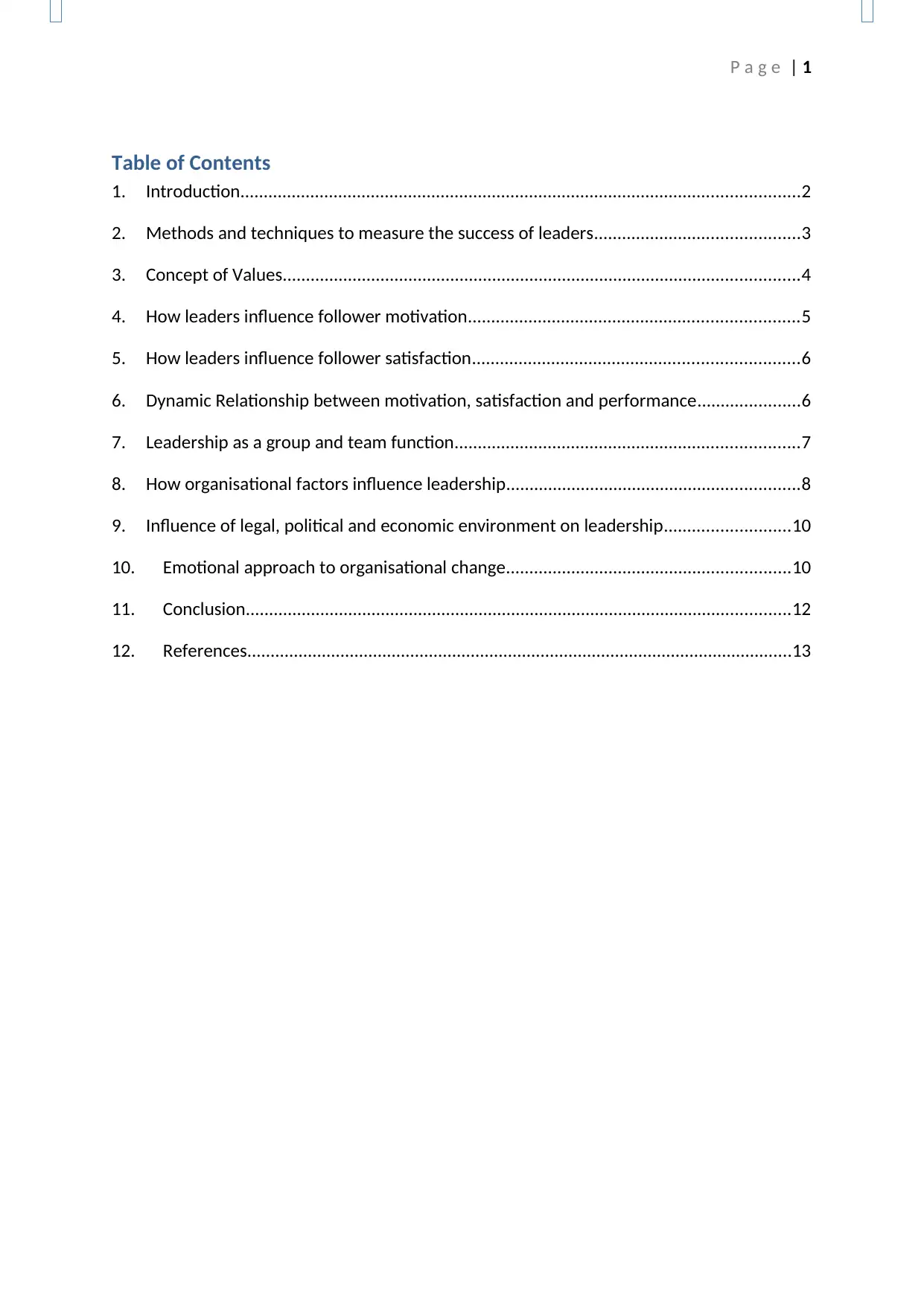
P a g e | 1
Table of Contents
1. Introduction........................................................................................................................2
2. Methods and techniques to measure the success of leaders............................................3
3. Concept of Values...............................................................................................................4
4. How leaders influence follower motivation.......................................................................5
5. How leaders influence follower satisfaction......................................................................6
6. Dynamic Relationship between motivation, satisfaction and performance......................6
7. Leadership as a group and team function..........................................................................7
8. How organisational factors influence leadership...............................................................8
9. Influence of legal, political and economic environment on leadership...........................10
10. Emotional approach to organisational change.............................................................10
11. Conclusion.....................................................................................................................12
12. References.....................................................................................................................13
Table of Contents
1. Introduction........................................................................................................................2
2. Methods and techniques to measure the success of leaders............................................3
3. Concept of Values...............................................................................................................4
4. How leaders influence follower motivation.......................................................................5
5. How leaders influence follower satisfaction......................................................................6
6. Dynamic Relationship between motivation, satisfaction and performance......................6
7. Leadership as a group and team function..........................................................................7
8. How organisational factors influence leadership...............................................................8
9. Influence of legal, political and economic environment on leadership...........................10
10. Emotional approach to organisational change.............................................................10
11. Conclusion.....................................................................................................................12
12. References.....................................................................................................................13
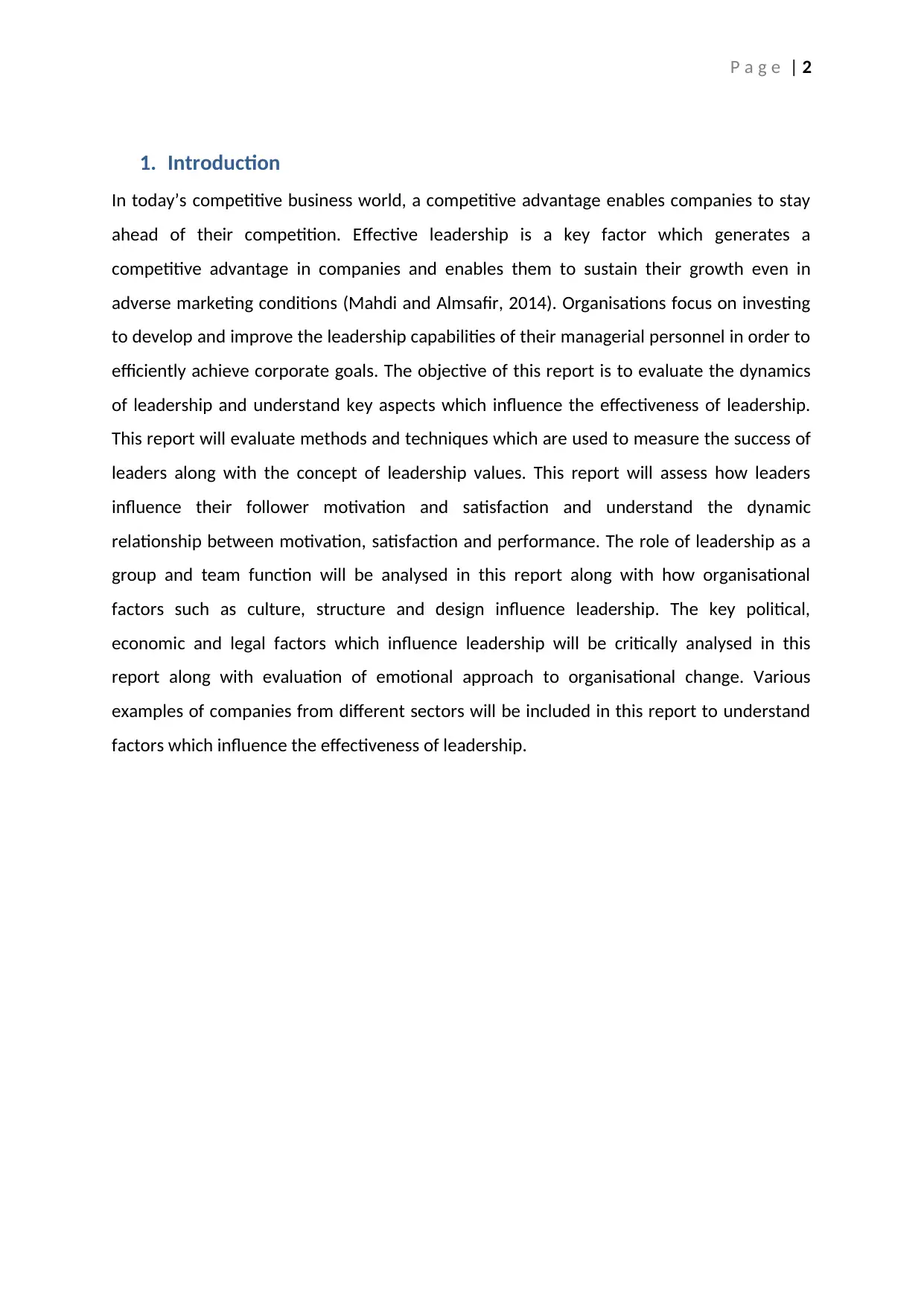
P a g e | 2
1. Introduction
In today’s competitive business world, a competitive advantage enables companies to stay
ahead of their competition. Effective leadership is a key factor which generates a
competitive advantage in companies and enables them to sustain their growth even in
adverse marketing conditions (Mahdi and Almsafir, 2014). Organisations focus on investing
to develop and improve the leadership capabilities of their managerial personnel in order to
efficiently achieve corporate goals. The objective of this report is to evaluate the dynamics
of leadership and understand key aspects which influence the effectiveness of leadership.
This report will evaluate methods and techniques which are used to measure the success of
leaders along with the concept of leadership values. This report will assess how leaders
influence their follower motivation and satisfaction and understand the dynamic
relationship between motivation, satisfaction and performance. The role of leadership as a
group and team function will be analysed in this report along with how organisational
factors such as culture, structure and design influence leadership. The key political,
economic and legal factors which influence leadership will be critically analysed in this
report along with evaluation of emotional approach to organisational change. Various
examples of companies from different sectors will be included in this report to understand
factors which influence the effectiveness of leadership.
1. Introduction
In today’s competitive business world, a competitive advantage enables companies to stay
ahead of their competition. Effective leadership is a key factor which generates a
competitive advantage in companies and enables them to sustain their growth even in
adverse marketing conditions (Mahdi and Almsafir, 2014). Organisations focus on investing
to develop and improve the leadership capabilities of their managerial personnel in order to
efficiently achieve corporate goals. The objective of this report is to evaluate the dynamics
of leadership and understand key aspects which influence the effectiveness of leadership.
This report will evaluate methods and techniques which are used to measure the success of
leaders along with the concept of leadership values. This report will assess how leaders
influence their follower motivation and satisfaction and understand the dynamic
relationship between motivation, satisfaction and performance. The role of leadership as a
group and team function will be analysed in this report along with how organisational
factors such as culture, structure and design influence leadership. The key political,
economic and legal factors which influence leadership will be critically analysed in this
report along with evaluation of emotional approach to organisational change. Various
examples of companies from different sectors will be included in this report to understand
factors which influence the effectiveness of leadership.
⊘ This is a preview!⊘
Do you want full access?
Subscribe today to unlock all pages.

Trusted by 1+ million students worldwide
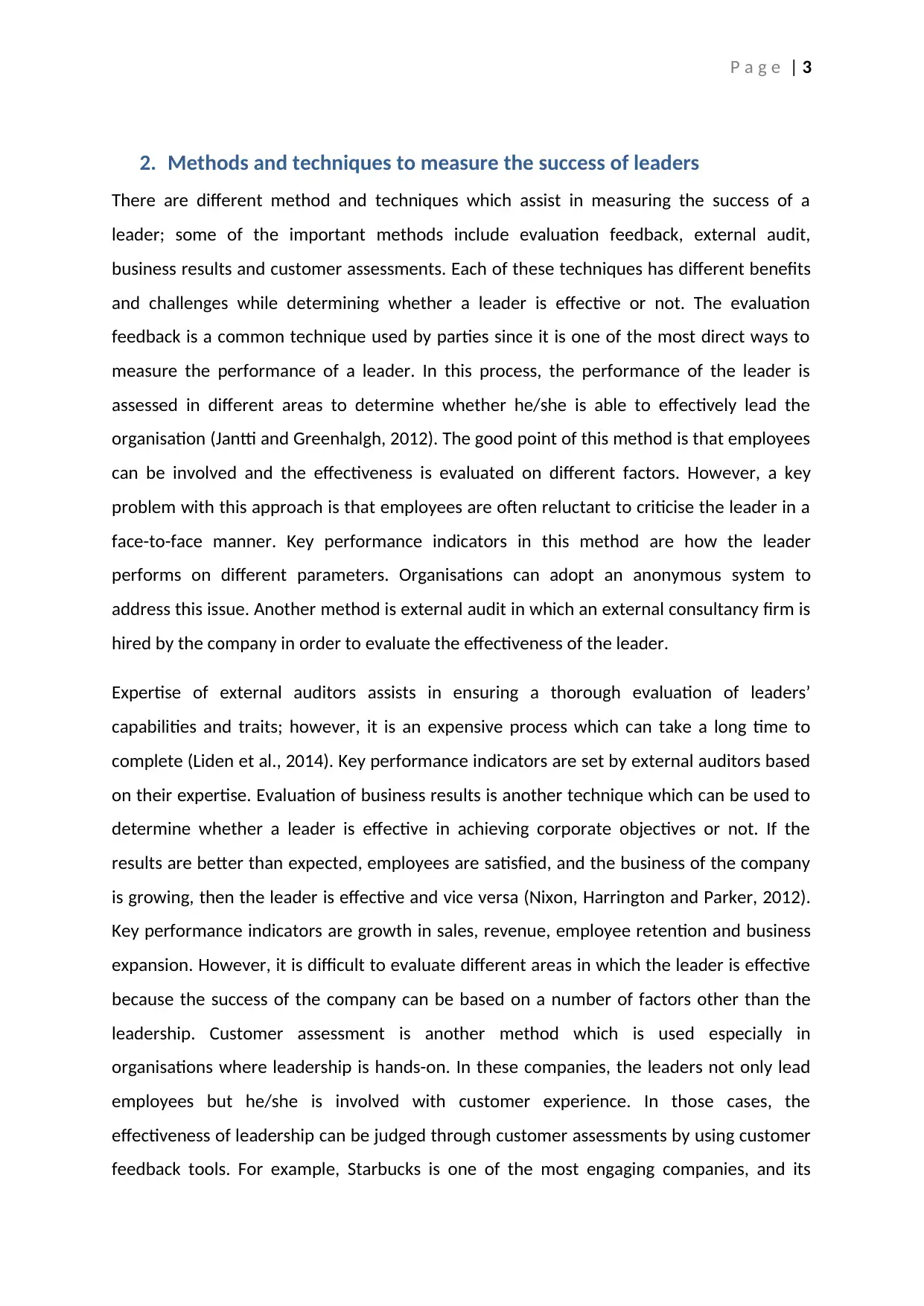
P a g e | 3
2. Methods and techniques to measure the success of leaders
There are different method and techniques which assist in measuring the success of a
leader; some of the important methods include evaluation feedback, external audit,
business results and customer assessments. Each of these techniques has different benefits
and challenges while determining whether a leader is effective or not. The evaluation
feedback is a common technique used by parties since it is one of the most direct ways to
measure the performance of a leader. In this process, the performance of the leader is
assessed in different areas to determine whether he/she is able to effectively lead the
organisation (Jantti and Greenhalgh, 2012). The good point of this method is that employees
can be involved and the effectiveness is evaluated on different factors. However, a key
problem with this approach is that employees are often reluctant to criticise the leader in a
face-to-face manner. Key performance indicators in this method are how the leader
performs on different parameters. Organisations can adopt an anonymous system to
address this issue. Another method is external audit in which an external consultancy firm is
hired by the company in order to evaluate the effectiveness of the leader.
Expertise of external auditors assists in ensuring a thorough evaluation of leaders’
capabilities and traits; however, it is an expensive process which can take a long time to
complete (Liden et al., 2014). Key performance indicators are set by external auditors based
on their expertise. Evaluation of business results is another technique which can be used to
determine whether a leader is effective in achieving corporate objectives or not. If the
results are better than expected, employees are satisfied, and the business of the company
is growing, then the leader is effective and vice versa (Nixon, Harrington and Parker, 2012).
Key performance indicators are growth in sales, revenue, employee retention and business
expansion. However, it is difficult to evaluate different areas in which the leader is effective
because the success of the company can be based on a number of factors other than the
leadership. Customer assessment is another method which is used especially in
organisations where leadership is hands-on. In these companies, the leaders not only lead
employees but he/she is involved with customer experience. In those cases, the
effectiveness of leadership can be judged through customer assessments by using customer
feedback tools. For example, Starbucks is one of the most engaging companies, and its
2. Methods and techniques to measure the success of leaders
There are different method and techniques which assist in measuring the success of a
leader; some of the important methods include evaluation feedback, external audit,
business results and customer assessments. Each of these techniques has different benefits
and challenges while determining whether a leader is effective or not. The evaluation
feedback is a common technique used by parties since it is one of the most direct ways to
measure the performance of a leader. In this process, the performance of the leader is
assessed in different areas to determine whether he/she is able to effectively lead the
organisation (Jantti and Greenhalgh, 2012). The good point of this method is that employees
can be involved and the effectiveness is evaluated on different factors. However, a key
problem with this approach is that employees are often reluctant to criticise the leader in a
face-to-face manner. Key performance indicators in this method are how the leader
performs on different parameters. Organisations can adopt an anonymous system to
address this issue. Another method is external audit in which an external consultancy firm is
hired by the company in order to evaluate the effectiveness of the leader.
Expertise of external auditors assists in ensuring a thorough evaluation of leaders’
capabilities and traits; however, it is an expensive process which can take a long time to
complete (Liden et al., 2014). Key performance indicators are set by external auditors based
on their expertise. Evaluation of business results is another technique which can be used to
determine whether a leader is effective in achieving corporate objectives or not. If the
results are better than expected, employees are satisfied, and the business of the company
is growing, then the leader is effective and vice versa (Nixon, Harrington and Parker, 2012).
Key performance indicators are growth in sales, revenue, employee retention and business
expansion. However, it is difficult to evaluate different areas in which the leader is effective
because the success of the company can be based on a number of factors other than the
leadership. Customer assessment is another method which is used especially in
organisations where leadership is hands-on. In these companies, the leaders not only lead
employees but he/she is involved with customer experience. In those cases, the
effectiveness of leadership can be judged through customer assessments by using customer
feedback tools. For example, Starbucks is one of the most engaging companies, and its
Paraphrase This Document
Need a fresh take? Get an instant paraphrase of this document with our AI Paraphraser
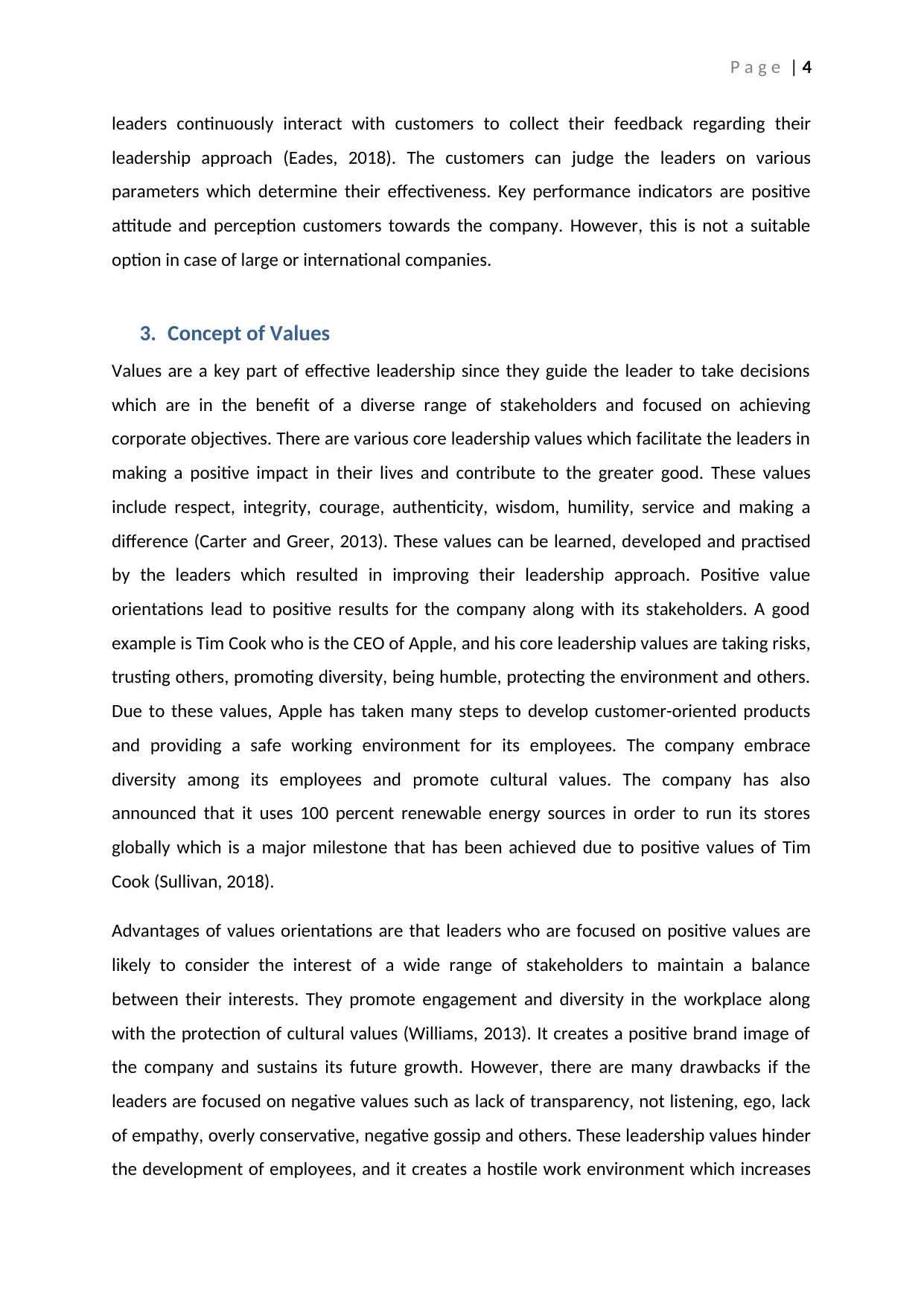
P a g e | 4
leaders continuously interact with customers to collect their feedback regarding their
leadership approach (Eades, 2018). The customers can judge the leaders on various
parameters which determine their effectiveness. Key performance indicators are positive
attitude and perception customers towards the company. However, this is not a suitable
option in case of large or international companies.
3. Concept of Values
Values are a key part of effective leadership since they guide the leader to take decisions
which are in the benefit of a diverse range of stakeholders and focused on achieving
corporate objectives. There are various core leadership values which facilitate the leaders in
making a positive impact in their lives and contribute to the greater good. These values
include respect, integrity, courage, authenticity, wisdom, humility, service and making a
difference (Carter and Greer, 2013). These values can be learned, developed and practised
by the leaders which resulted in improving their leadership approach. Positive value
orientations lead to positive results for the company along with its stakeholders. A good
example is Tim Cook who is the CEO of Apple, and his core leadership values are taking risks,
trusting others, promoting diversity, being humble, protecting the environment and others.
Due to these values, Apple has taken many steps to develop customer-oriented products
and providing a safe working environment for its employees. The company embrace
diversity among its employees and promote cultural values. The company has also
announced that it uses 100 percent renewable energy sources in order to run its stores
globally which is a major milestone that has been achieved due to positive values of Tim
Cook (Sullivan, 2018).
Advantages of values orientations are that leaders who are focused on positive values are
likely to consider the interest of a wide range of stakeholders to maintain a balance
between their interests. They promote engagement and diversity in the workplace along
with the protection of cultural values (Williams, 2013). It creates a positive brand image of
the company and sustains its future growth. However, there are many drawbacks if the
leaders are focused on negative values such as lack of transparency, not listening, ego, lack
of empathy, overly conservative, negative gossip and others. These leadership values hinder
the development of employees, and it creates a hostile work environment which increases
leaders continuously interact with customers to collect their feedback regarding their
leadership approach (Eades, 2018). The customers can judge the leaders on various
parameters which determine their effectiveness. Key performance indicators are positive
attitude and perception customers towards the company. However, this is not a suitable
option in case of large or international companies.
3. Concept of Values
Values are a key part of effective leadership since they guide the leader to take decisions
which are in the benefit of a diverse range of stakeholders and focused on achieving
corporate objectives. There are various core leadership values which facilitate the leaders in
making a positive impact in their lives and contribute to the greater good. These values
include respect, integrity, courage, authenticity, wisdom, humility, service and making a
difference (Carter and Greer, 2013). These values can be learned, developed and practised
by the leaders which resulted in improving their leadership approach. Positive value
orientations lead to positive results for the company along with its stakeholders. A good
example is Tim Cook who is the CEO of Apple, and his core leadership values are taking risks,
trusting others, promoting diversity, being humble, protecting the environment and others.
Due to these values, Apple has taken many steps to develop customer-oriented products
and providing a safe working environment for its employees. The company embrace
diversity among its employees and promote cultural values. The company has also
announced that it uses 100 percent renewable energy sources in order to run its stores
globally which is a major milestone that has been achieved due to positive values of Tim
Cook (Sullivan, 2018).
Advantages of values orientations are that leaders who are focused on positive values are
likely to consider the interest of a wide range of stakeholders to maintain a balance
between their interests. They promote engagement and diversity in the workplace along
with the protection of cultural values (Williams, 2013). It creates a positive brand image of
the company and sustains its future growth. However, there are many drawbacks if the
leaders are focused on negative values such as lack of transparency, not listening, ego, lack
of empathy, overly conservative, negative gossip and others. These leadership values hinder
the development of employees, and it creates a hostile work environment which increases
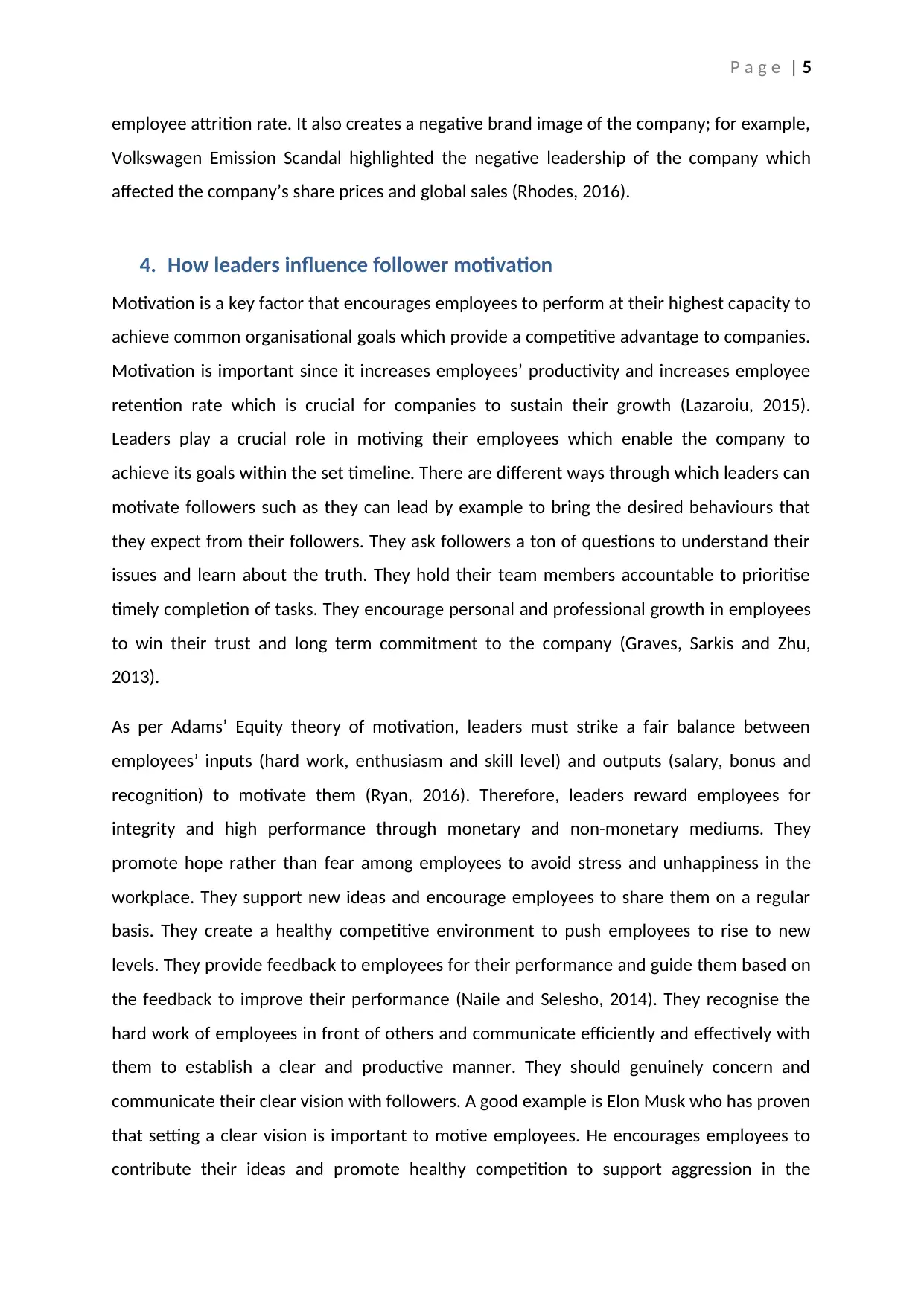
P a g e | 5
employee attrition rate. It also creates a negative brand image of the company; for example,
Volkswagen Emission Scandal highlighted the negative leadership of the company which
affected the company’s share prices and global sales (Rhodes, 2016).
4. How leaders influence follower motivation
Motivation is a key factor that encourages employees to perform at their highest capacity to
achieve common organisational goals which provide a competitive advantage to companies.
Motivation is important since it increases employees’ productivity and increases employee
retention rate which is crucial for companies to sustain their growth (Lazaroiu, 2015).
Leaders play a crucial role in motiving their employees which enable the company to
achieve its goals within the set timeline. There are different ways through which leaders can
motivate followers such as they can lead by example to bring the desired behaviours that
they expect from their followers. They ask followers a ton of questions to understand their
issues and learn about the truth. They hold their team members accountable to prioritise
timely completion of tasks. They encourage personal and professional growth in employees
to win their trust and long term commitment to the company (Graves, Sarkis and Zhu,
2013).
As per Adams’ Equity theory of motivation, leaders must strike a fair balance between
employees’ inputs (hard work, enthusiasm and skill level) and outputs (salary, bonus and
recognition) to motivate them (Ryan, 2016). Therefore, leaders reward employees for
integrity and high performance through monetary and non-monetary mediums. They
promote hope rather than fear among employees to avoid stress and unhappiness in the
workplace. They support new ideas and encourage employees to share them on a regular
basis. They create a healthy competitive environment to push employees to rise to new
levels. They provide feedback to employees for their performance and guide them based on
the feedback to improve their performance (Naile and Selesho, 2014). They recognise the
hard work of employees in front of others and communicate efficiently and effectively with
them to establish a clear and productive manner. They should genuinely concern and
communicate their clear vision with followers. A good example is Elon Musk who has proven
that setting a clear vision is important to motive employees. He encourages employees to
contribute their ideas and promote healthy competition to support aggression in the
employee attrition rate. It also creates a negative brand image of the company; for example,
Volkswagen Emission Scandal highlighted the negative leadership of the company which
affected the company’s share prices and global sales (Rhodes, 2016).
4. How leaders influence follower motivation
Motivation is a key factor that encourages employees to perform at their highest capacity to
achieve common organisational goals which provide a competitive advantage to companies.
Motivation is important since it increases employees’ productivity and increases employee
retention rate which is crucial for companies to sustain their growth (Lazaroiu, 2015).
Leaders play a crucial role in motiving their employees which enable the company to
achieve its goals within the set timeline. There are different ways through which leaders can
motivate followers such as they can lead by example to bring the desired behaviours that
they expect from their followers. They ask followers a ton of questions to understand their
issues and learn about the truth. They hold their team members accountable to prioritise
timely completion of tasks. They encourage personal and professional growth in employees
to win their trust and long term commitment to the company (Graves, Sarkis and Zhu,
2013).
As per Adams’ Equity theory of motivation, leaders must strike a fair balance between
employees’ inputs (hard work, enthusiasm and skill level) and outputs (salary, bonus and
recognition) to motivate them (Ryan, 2016). Therefore, leaders reward employees for
integrity and high performance through monetary and non-monetary mediums. They
promote hope rather than fear among employees to avoid stress and unhappiness in the
workplace. They support new ideas and encourage employees to share them on a regular
basis. They create a healthy competitive environment to push employees to rise to new
levels. They provide feedback to employees for their performance and guide them based on
the feedback to improve their performance (Naile and Selesho, 2014). They recognise the
hard work of employees in front of others and communicate efficiently and effectively with
them to establish a clear and productive manner. They should genuinely concern and
communicate their clear vision with followers. A good example is Elon Musk who has proven
that setting a clear vision is important to motive employees. He encourages employees to
contribute their ideas and promote healthy competition to support aggression in the
⊘ This is a preview!⊘
Do you want full access?
Subscribe today to unlock all pages.

Trusted by 1+ million students worldwide
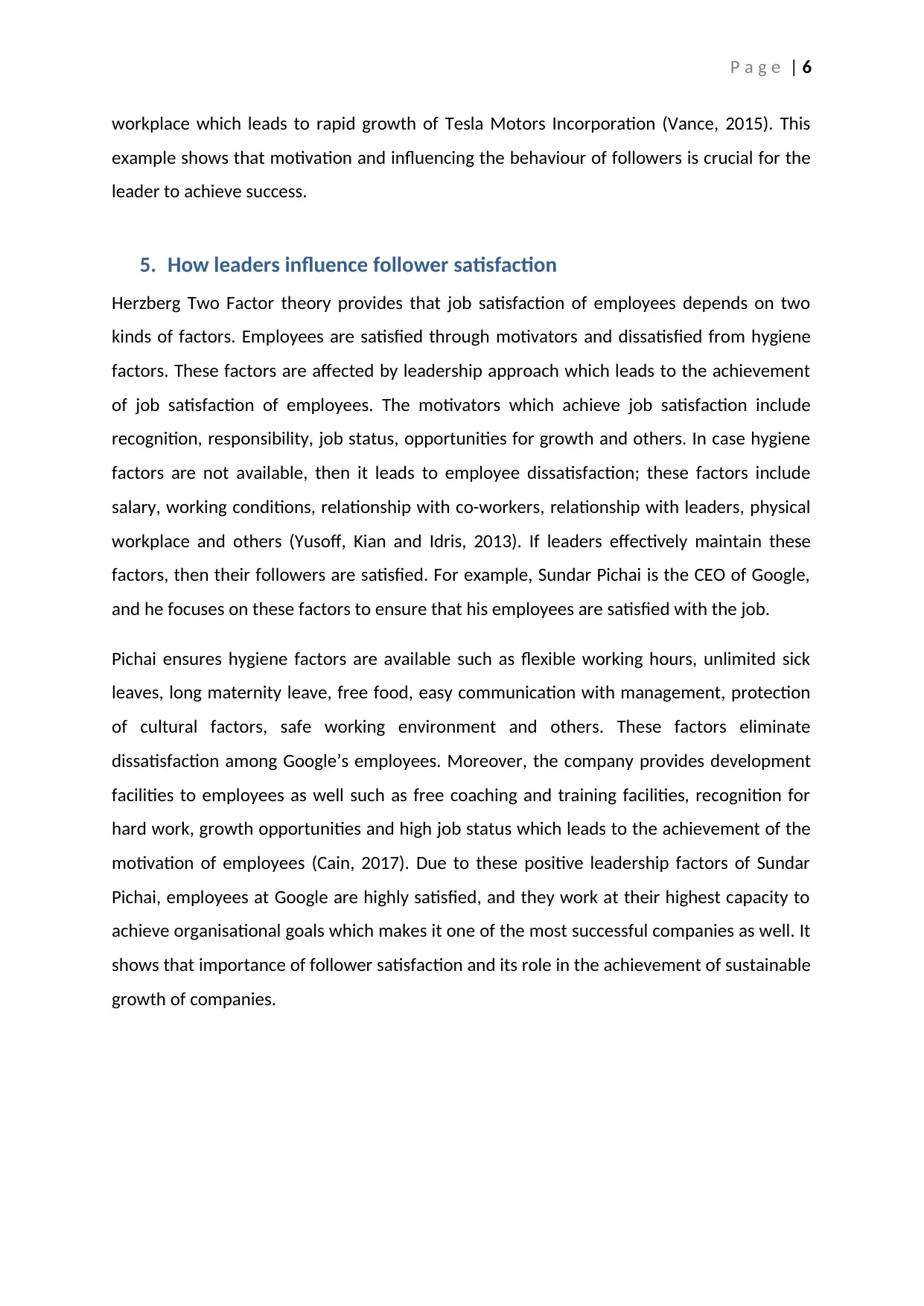
P a g e | 6
workplace which leads to rapid growth of Tesla Motors Incorporation (Vance, 2015). This
example shows that motivation and influencing the behaviour of followers is crucial for the
leader to achieve success.
5. How leaders influence follower satisfaction
Herzberg Two Factor theory provides that job satisfaction of employees depends on two
kinds of factors. Employees are satisfied through motivators and dissatisfied from hygiene
factors. These factors are affected by leadership approach which leads to the achievement
of job satisfaction of employees. The motivators which achieve job satisfaction include
recognition, responsibility, job status, opportunities for growth and others. In case hygiene
factors are not available, then it leads to employee dissatisfaction; these factors include
salary, working conditions, relationship with co-workers, relationship with leaders, physical
workplace and others (Yusoff, Kian and Idris, 2013). If leaders effectively maintain these
factors, then their followers are satisfied. For example, Sundar Pichai is the CEO of Google,
and he focuses on these factors to ensure that his employees are satisfied with the job.
Pichai ensures hygiene factors are available such as flexible working hours, unlimited sick
leaves, long maternity leave, free food, easy communication with management, protection
of cultural factors, safe working environment and others. These factors eliminate
dissatisfaction among Google’s employees. Moreover, the company provides development
facilities to employees as well such as free coaching and training facilities, recognition for
hard work, growth opportunities and high job status which leads to the achievement of the
motivation of employees (Cain, 2017). Due to these positive leadership factors of Sundar
Pichai, employees at Google are highly satisfied, and they work at their highest capacity to
achieve organisational goals which makes it one of the most successful companies as well. It
shows that importance of follower satisfaction and its role in the achievement of sustainable
growth of companies.
workplace which leads to rapid growth of Tesla Motors Incorporation (Vance, 2015). This
example shows that motivation and influencing the behaviour of followers is crucial for the
leader to achieve success.
5. How leaders influence follower satisfaction
Herzberg Two Factor theory provides that job satisfaction of employees depends on two
kinds of factors. Employees are satisfied through motivators and dissatisfied from hygiene
factors. These factors are affected by leadership approach which leads to the achievement
of job satisfaction of employees. The motivators which achieve job satisfaction include
recognition, responsibility, job status, opportunities for growth and others. In case hygiene
factors are not available, then it leads to employee dissatisfaction; these factors include
salary, working conditions, relationship with co-workers, relationship with leaders, physical
workplace and others (Yusoff, Kian and Idris, 2013). If leaders effectively maintain these
factors, then their followers are satisfied. For example, Sundar Pichai is the CEO of Google,
and he focuses on these factors to ensure that his employees are satisfied with the job.
Pichai ensures hygiene factors are available such as flexible working hours, unlimited sick
leaves, long maternity leave, free food, easy communication with management, protection
of cultural factors, safe working environment and others. These factors eliminate
dissatisfaction among Google’s employees. Moreover, the company provides development
facilities to employees as well such as free coaching and training facilities, recognition for
hard work, growth opportunities and high job status which leads to the achievement of the
motivation of employees (Cain, 2017). Due to these positive leadership factors of Sundar
Pichai, employees at Google are highly satisfied, and they work at their highest capacity to
achieve organisational goals which makes it one of the most successful companies as well. It
shows that importance of follower satisfaction and its role in the achievement of sustainable
growth of companies.
Paraphrase This Document
Need a fresh take? Get an instant paraphrase of this document with our AI Paraphraser
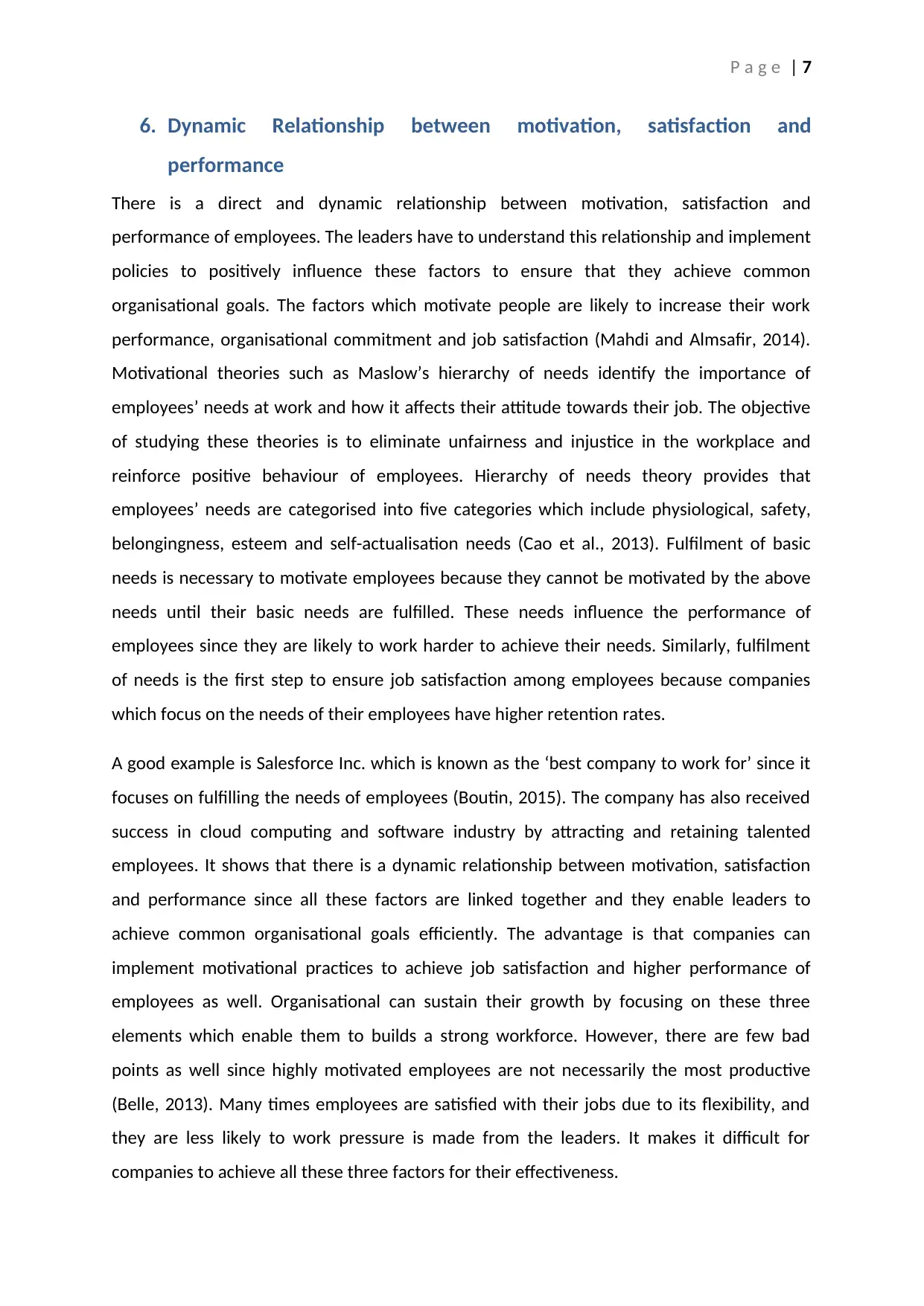
P a g e | 7
6. Dynamic Relationship between motivation, satisfaction and
performance
There is a direct and dynamic relationship between motivation, satisfaction and
performance of employees. The leaders have to understand this relationship and implement
policies to positively influence these factors to ensure that they achieve common
organisational goals. The factors which motivate people are likely to increase their work
performance, organisational commitment and job satisfaction (Mahdi and Almsafir, 2014).
Motivational theories such as Maslow’s hierarchy of needs identify the importance of
employees’ needs at work and how it affects their attitude towards their job. The objective
of studying these theories is to eliminate unfairness and injustice in the workplace and
reinforce positive behaviour of employees. Hierarchy of needs theory provides that
employees’ needs are categorised into five categories which include physiological, safety,
belongingness, esteem and self-actualisation needs (Cao et al., 2013). Fulfilment of basic
needs is necessary to motivate employees because they cannot be motivated by the above
needs until their basic needs are fulfilled. These needs influence the performance of
employees since they are likely to work harder to achieve their needs. Similarly, fulfilment
of needs is the first step to ensure job satisfaction among employees because companies
which focus on the needs of their employees have higher retention rates.
A good example is Salesforce Inc. which is known as the ‘best company to work for’ since it
focuses on fulfilling the needs of employees (Boutin, 2015). The company has also received
success in cloud computing and software industry by attracting and retaining talented
employees. It shows that there is a dynamic relationship between motivation, satisfaction
and performance since all these factors are linked together and they enable leaders to
achieve common organisational goals efficiently. The advantage is that companies can
implement motivational practices to achieve job satisfaction and higher performance of
employees as well. Organisational can sustain their growth by focusing on these three
elements which enable them to builds a strong workforce. However, there are few bad
points as well since highly motivated employees are not necessarily the most productive
(Belle, 2013). Many times employees are satisfied with their jobs due to its flexibility, and
they are less likely to work pressure is made from the leaders. It makes it difficult for
companies to achieve all these three factors for their effectiveness.
6. Dynamic Relationship between motivation, satisfaction and
performance
There is a direct and dynamic relationship between motivation, satisfaction and
performance of employees. The leaders have to understand this relationship and implement
policies to positively influence these factors to ensure that they achieve common
organisational goals. The factors which motivate people are likely to increase their work
performance, organisational commitment and job satisfaction (Mahdi and Almsafir, 2014).
Motivational theories such as Maslow’s hierarchy of needs identify the importance of
employees’ needs at work and how it affects their attitude towards their job. The objective
of studying these theories is to eliminate unfairness and injustice in the workplace and
reinforce positive behaviour of employees. Hierarchy of needs theory provides that
employees’ needs are categorised into five categories which include physiological, safety,
belongingness, esteem and self-actualisation needs (Cao et al., 2013). Fulfilment of basic
needs is necessary to motivate employees because they cannot be motivated by the above
needs until their basic needs are fulfilled. These needs influence the performance of
employees since they are likely to work harder to achieve their needs. Similarly, fulfilment
of needs is the first step to ensure job satisfaction among employees because companies
which focus on the needs of their employees have higher retention rates.
A good example is Salesforce Inc. which is known as the ‘best company to work for’ since it
focuses on fulfilling the needs of employees (Boutin, 2015). The company has also received
success in cloud computing and software industry by attracting and retaining talented
employees. It shows that there is a dynamic relationship between motivation, satisfaction
and performance since all these factors are linked together and they enable leaders to
achieve common organisational goals efficiently. The advantage is that companies can
implement motivational practices to achieve job satisfaction and higher performance of
employees as well. Organisational can sustain their growth by focusing on these three
elements which enable them to builds a strong workforce. However, there are few bad
points as well since highly motivated employees are not necessarily the most productive
(Belle, 2013). Many times employees are satisfied with their jobs due to its flexibility, and
they are less likely to work pressure is made from the leaders. It makes it difficult for
companies to achieve all these three factors for their effectiveness.
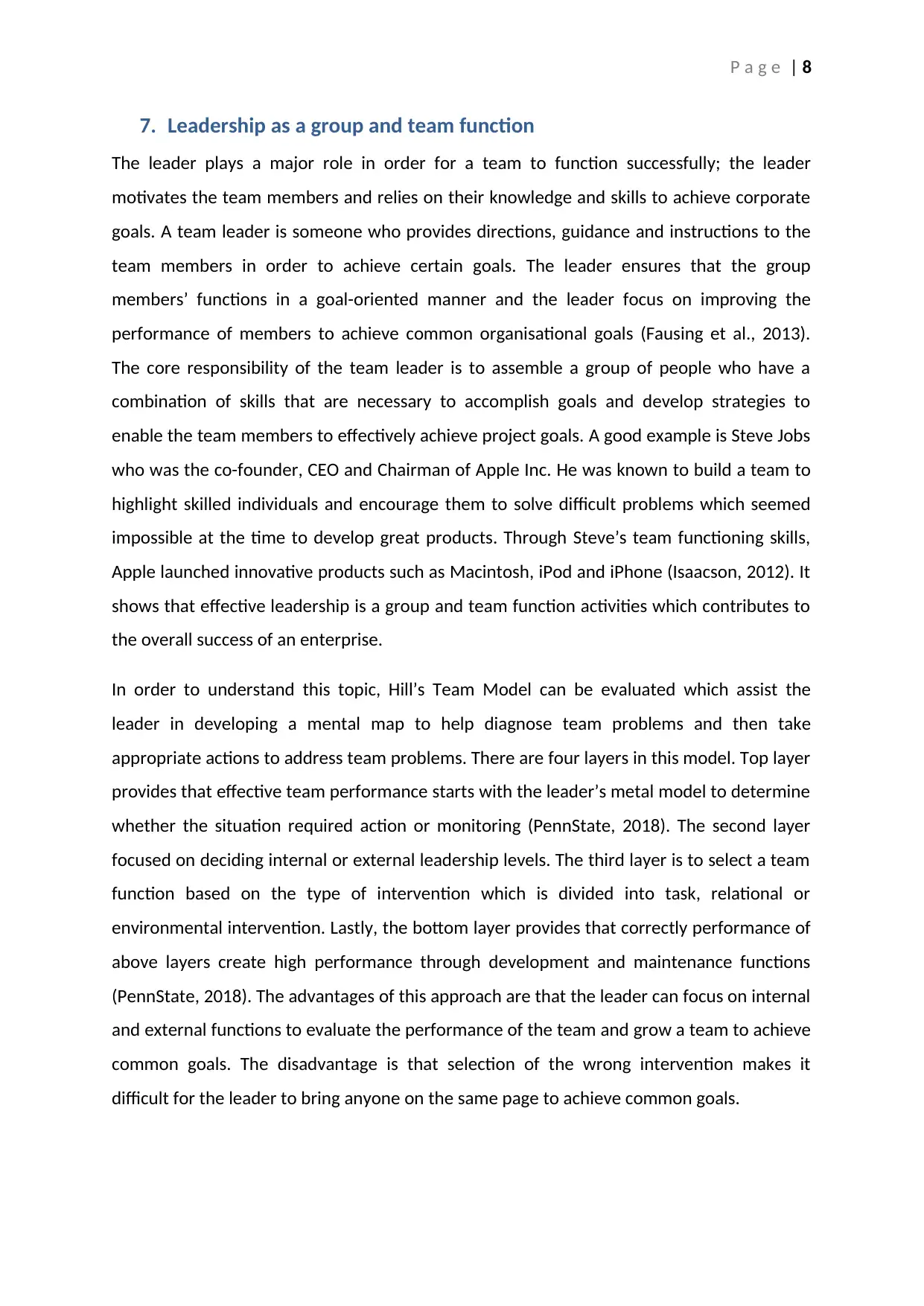
P a g e | 8
7. Leadership as a group and team function
The leader plays a major role in order for a team to function successfully; the leader
motivates the team members and relies on their knowledge and skills to achieve corporate
goals. A team leader is someone who provides directions, guidance and instructions to the
team members in order to achieve certain goals. The leader ensures that the group
members’ functions in a goal-oriented manner and the leader focus on improving the
performance of members to achieve common organisational goals (Fausing et al., 2013).
The core responsibility of the team leader is to assemble a group of people who have a
combination of skills that are necessary to accomplish goals and develop strategies to
enable the team members to effectively achieve project goals. A good example is Steve Jobs
who was the co-founder, CEO and Chairman of Apple Inc. He was known to build a team to
highlight skilled individuals and encourage them to solve difficult problems which seemed
impossible at the time to develop great products. Through Steve’s team functioning skills,
Apple launched innovative products such as Macintosh, iPod and iPhone (Isaacson, 2012). It
shows that effective leadership is a group and team function activities which contributes to
the overall success of an enterprise.
In order to understand this topic, Hill’s Team Model can be evaluated which assist the
leader in developing a mental map to help diagnose team problems and then take
appropriate actions to address team problems. There are four layers in this model. Top layer
provides that effective team performance starts with the leader’s metal model to determine
whether the situation required action or monitoring (PennState, 2018). The second layer
focused on deciding internal or external leadership levels. The third layer is to select a team
function based on the type of intervention which is divided into task, relational or
environmental intervention. Lastly, the bottom layer provides that correctly performance of
above layers create high performance through development and maintenance functions
(PennState, 2018). The advantages of this approach are that the leader can focus on internal
and external functions to evaluate the performance of the team and grow a team to achieve
common goals. The disadvantage is that selection of the wrong intervention makes it
difficult for the leader to bring anyone on the same page to achieve common goals.
7. Leadership as a group and team function
The leader plays a major role in order for a team to function successfully; the leader
motivates the team members and relies on their knowledge and skills to achieve corporate
goals. A team leader is someone who provides directions, guidance and instructions to the
team members in order to achieve certain goals. The leader ensures that the group
members’ functions in a goal-oriented manner and the leader focus on improving the
performance of members to achieve common organisational goals (Fausing et al., 2013).
The core responsibility of the team leader is to assemble a group of people who have a
combination of skills that are necessary to accomplish goals and develop strategies to
enable the team members to effectively achieve project goals. A good example is Steve Jobs
who was the co-founder, CEO and Chairman of Apple Inc. He was known to build a team to
highlight skilled individuals and encourage them to solve difficult problems which seemed
impossible at the time to develop great products. Through Steve’s team functioning skills,
Apple launched innovative products such as Macintosh, iPod and iPhone (Isaacson, 2012). It
shows that effective leadership is a group and team function activities which contributes to
the overall success of an enterprise.
In order to understand this topic, Hill’s Team Model can be evaluated which assist the
leader in developing a mental map to help diagnose team problems and then take
appropriate actions to address team problems. There are four layers in this model. Top layer
provides that effective team performance starts with the leader’s metal model to determine
whether the situation required action or monitoring (PennState, 2018). The second layer
focused on deciding internal or external leadership levels. The third layer is to select a team
function based on the type of intervention which is divided into task, relational or
environmental intervention. Lastly, the bottom layer provides that correctly performance of
above layers create high performance through development and maintenance functions
(PennState, 2018). The advantages of this approach are that the leader can focus on internal
and external functions to evaluate the performance of the team and grow a team to achieve
common goals. The disadvantage is that selection of the wrong intervention makes it
difficult for the leader to bring anyone on the same page to achieve common goals.
⊘ This is a preview!⊘
Do you want full access?
Subscribe today to unlock all pages.

Trusted by 1+ million students worldwide
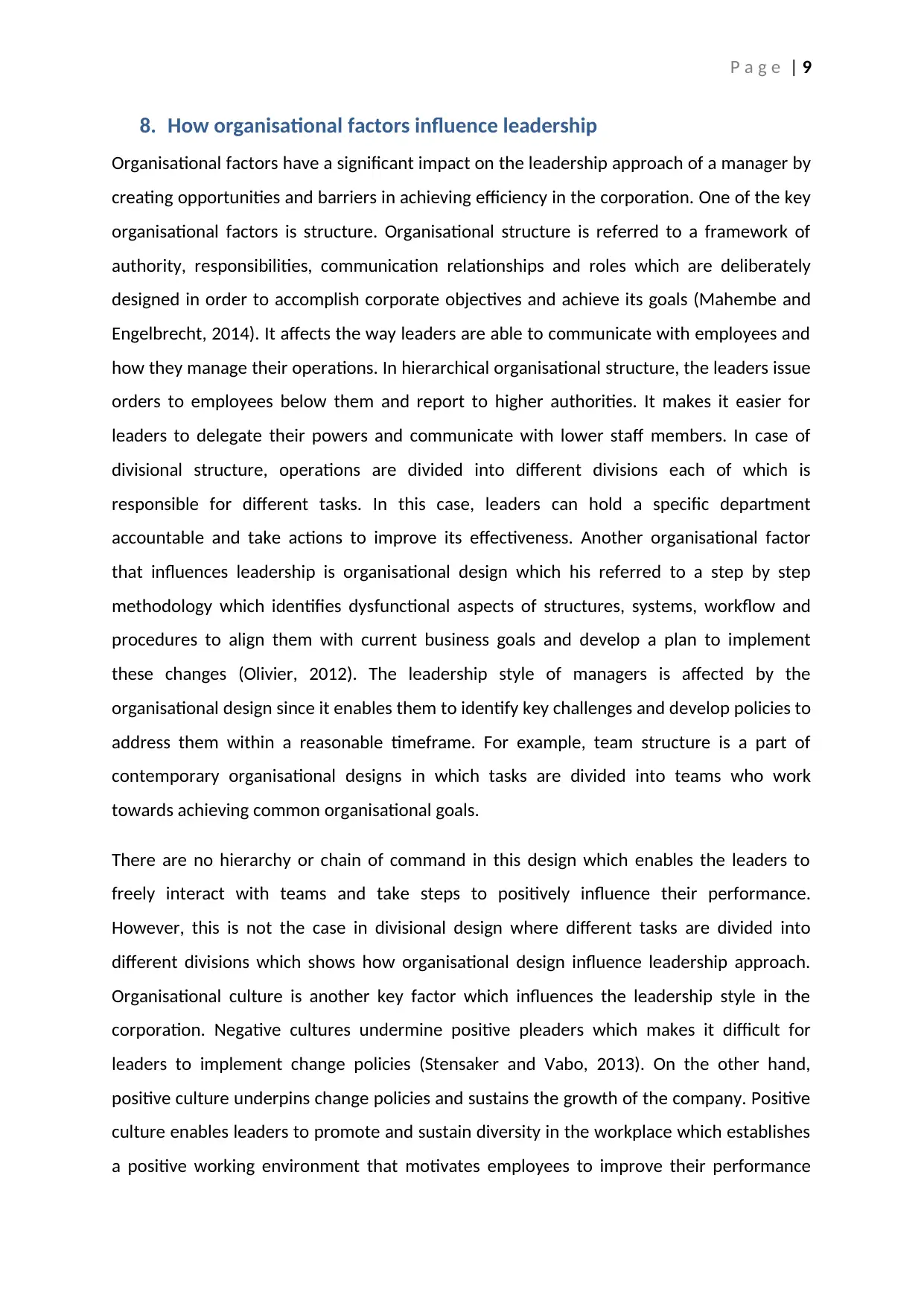
P a g e | 9
8. How organisational factors influence leadership
Organisational factors have a significant impact on the leadership approach of a manager by
creating opportunities and barriers in achieving efficiency in the corporation. One of the key
organisational factors is structure. Organisational structure is referred to a framework of
authority, responsibilities, communication relationships and roles which are deliberately
designed in order to accomplish corporate objectives and achieve its goals (Mahembe and
Engelbrecht, 2014). It affects the way leaders are able to communicate with employees and
how they manage their operations. In hierarchical organisational structure, the leaders issue
orders to employees below them and report to higher authorities. It makes it easier for
leaders to delegate their powers and communicate with lower staff members. In case of
divisional structure, operations are divided into different divisions each of which is
responsible for different tasks. In this case, leaders can hold a specific department
accountable and take actions to improve its effectiveness. Another organisational factor
that influences leadership is organisational design which his referred to a step by step
methodology which identifies dysfunctional aspects of structures, systems, workflow and
procedures to align them with current business goals and develop a plan to implement
these changes (Olivier, 2012). The leadership style of managers is affected by the
organisational design since it enables them to identify key challenges and develop policies to
address them within a reasonable timeframe. For example, team structure is a part of
contemporary organisational designs in which tasks are divided into teams who work
towards achieving common organisational goals.
There are no hierarchy or chain of command in this design which enables the leaders to
freely interact with teams and take steps to positively influence their performance.
However, this is not the case in divisional design where different tasks are divided into
different divisions which shows how organisational design influence leadership approach.
Organisational culture is another key factor which influences the leadership style in the
corporation. Negative cultures undermine positive pleaders which makes it difficult for
leaders to implement change policies (Stensaker and Vabo, 2013). On the other hand,
positive culture underpins change policies and sustains the growth of the company. Positive
culture enables leaders to promote and sustain diversity in the workplace which establishes
a positive working environment that motivates employees to improve their performance
8. How organisational factors influence leadership
Organisational factors have a significant impact on the leadership approach of a manager by
creating opportunities and barriers in achieving efficiency in the corporation. One of the key
organisational factors is structure. Organisational structure is referred to a framework of
authority, responsibilities, communication relationships and roles which are deliberately
designed in order to accomplish corporate objectives and achieve its goals (Mahembe and
Engelbrecht, 2014). It affects the way leaders are able to communicate with employees and
how they manage their operations. In hierarchical organisational structure, the leaders issue
orders to employees below them and report to higher authorities. It makes it easier for
leaders to delegate their powers and communicate with lower staff members. In case of
divisional structure, operations are divided into different divisions each of which is
responsible for different tasks. In this case, leaders can hold a specific department
accountable and take actions to improve its effectiveness. Another organisational factor
that influences leadership is organisational design which his referred to a step by step
methodology which identifies dysfunctional aspects of structures, systems, workflow and
procedures to align them with current business goals and develop a plan to implement
these changes (Olivier, 2012). The leadership style of managers is affected by the
organisational design since it enables them to identify key challenges and develop policies to
address them within a reasonable timeframe. For example, team structure is a part of
contemporary organisational designs in which tasks are divided into teams who work
towards achieving common organisational goals.
There are no hierarchy or chain of command in this design which enables the leaders to
freely interact with teams and take steps to positively influence their performance.
However, this is not the case in divisional design where different tasks are divided into
different divisions which shows how organisational design influence leadership approach.
Organisational culture is another key factor which influences the leadership style in the
corporation. Negative cultures undermine positive pleaders which makes it difficult for
leaders to implement change policies (Stensaker and Vabo, 2013). On the other hand,
positive culture underpins change policies and sustains the growth of the company. Positive
culture enables leaders to promote and sustain diversity in the workplace which establishes
a positive working environment that motivates employees to improve their performance
Paraphrase This Document
Need a fresh take? Get an instant paraphrase of this document with our AI Paraphraser
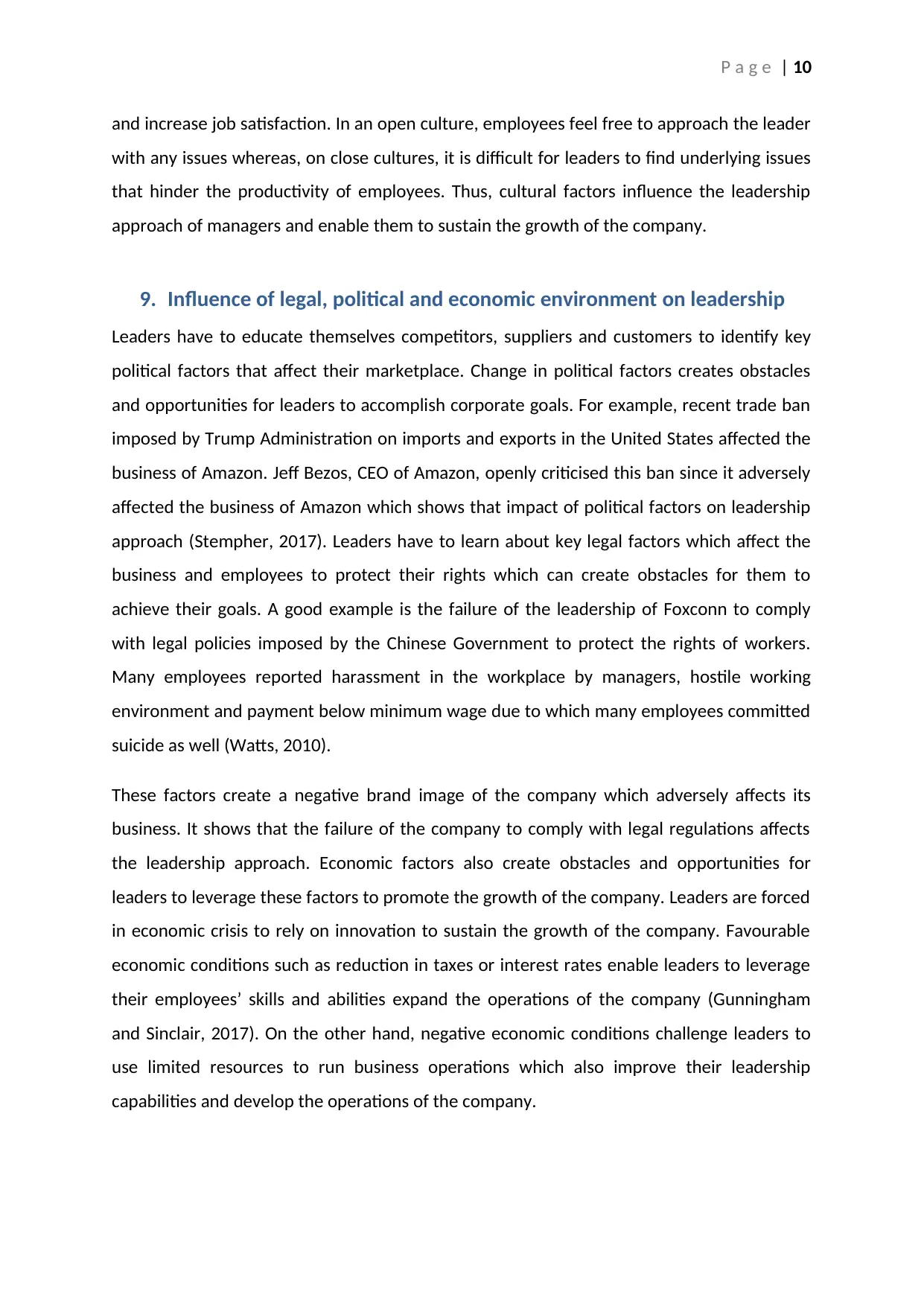
P a g e | 10
and increase job satisfaction. In an open culture, employees feel free to approach the leader
with any issues whereas, on close cultures, it is difficult for leaders to find underlying issues
that hinder the productivity of employees. Thus, cultural factors influence the leadership
approach of managers and enable them to sustain the growth of the company.
9. Influence of legal, political and economic environment on leadership
Leaders have to educate themselves competitors, suppliers and customers to identify key
political factors that affect their marketplace. Change in political factors creates obstacles
and opportunities for leaders to accomplish corporate goals. For example, recent trade ban
imposed by Trump Administration on imports and exports in the United States affected the
business of Amazon. Jeff Bezos, CEO of Amazon, openly criticised this ban since it adversely
affected the business of Amazon which shows that impact of political factors on leadership
approach (Stempher, 2017). Leaders have to learn about key legal factors which affect the
business and employees to protect their rights which can create obstacles for them to
achieve their goals. A good example is the failure of the leadership of Foxconn to comply
with legal policies imposed by the Chinese Government to protect the rights of workers.
Many employees reported harassment in the workplace by managers, hostile working
environment and payment below minimum wage due to which many employees committed
suicide as well (Watts, 2010).
These factors create a negative brand image of the company which adversely affects its
business. It shows that the failure of the company to comply with legal regulations affects
the leadership approach. Economic factors also create obstacles and opportunities for
leaders to leverage these factors to promote the growth of the company. Leaders are forced
in economic crisis to rely on innovation to sustain the growth of the company. Favourable
economic conditions such as reduction in taxes or interest rates enable leaders to leverage
their employees’ skills and abilities expand the operations of the company (Gunningham
and Sinclair, 2017). On the other hand, negative economic conditions challenge leaders to
use limited resources to run business operations which also improve their leadership
capabilities and develop the operations of the company.
and increase job satisfaction. In an open culture, employees feel free to approach the leader
with any issues whereas, on close cultures, it is difficult for leaders to find underlying issues
that hinder the productivity of employees. Thus, cultural factors influence the leadership
approach of managers and enable them to sustain the growth of the company.
9. Influence of legal, political and economic environment on leadership
Leaders have to educate themselves competitors, suppliers and customers to identify key
political factors that affect their marketplace. Change in political factors creates obstacles
and opportunities for leaders to accomplish corporate goals. For example, recent trade ban
imposed by Trump Administration on imports and exports in the United States affected the
business of Amazon. Jeff Bezos, CEO of Amazon, openly criticised this ban since it adversely
affected the business of Amazon which shows that impact of political factors on leadership
approach (Stempher, 2017). Leaders have to learn about key legal factors which affect the
business and employees to protect their rights which can create obstacles for them to
achieve their goals. A good example is the failure of the leadership of Foxconn to comply
with legal policies imposed by the Chinese Government to protect the rights of workers.
Many employees reported harassment in the workplace by managers, hostile working
environment and payment below minimum wage due to which many employees committed
suicide as well (Watts, 2010).
These factors create a negative brand image of the company which adversely affects its
business. It shows that the failure of the company to comply with legal regulations affects
the leadership approach. Economic factors also create obstacles and opportunities for
leaders to leverage these factors to promote the growth of the company. Leaders are forced
in economic crisis to rely on innovation to sustain the growth of the company. Favourable
economic conditions such as reduction in taxes or interest rates enable leaders to leverage
their employees’ skills and abilities expand the operations of the company (Gunningham
and Sinclair, 2017). On the other hand, negative economic conditions challenge leaders to
use limited resources to run business operations which also improve their leadership
capabilities and develop the operations of the company.
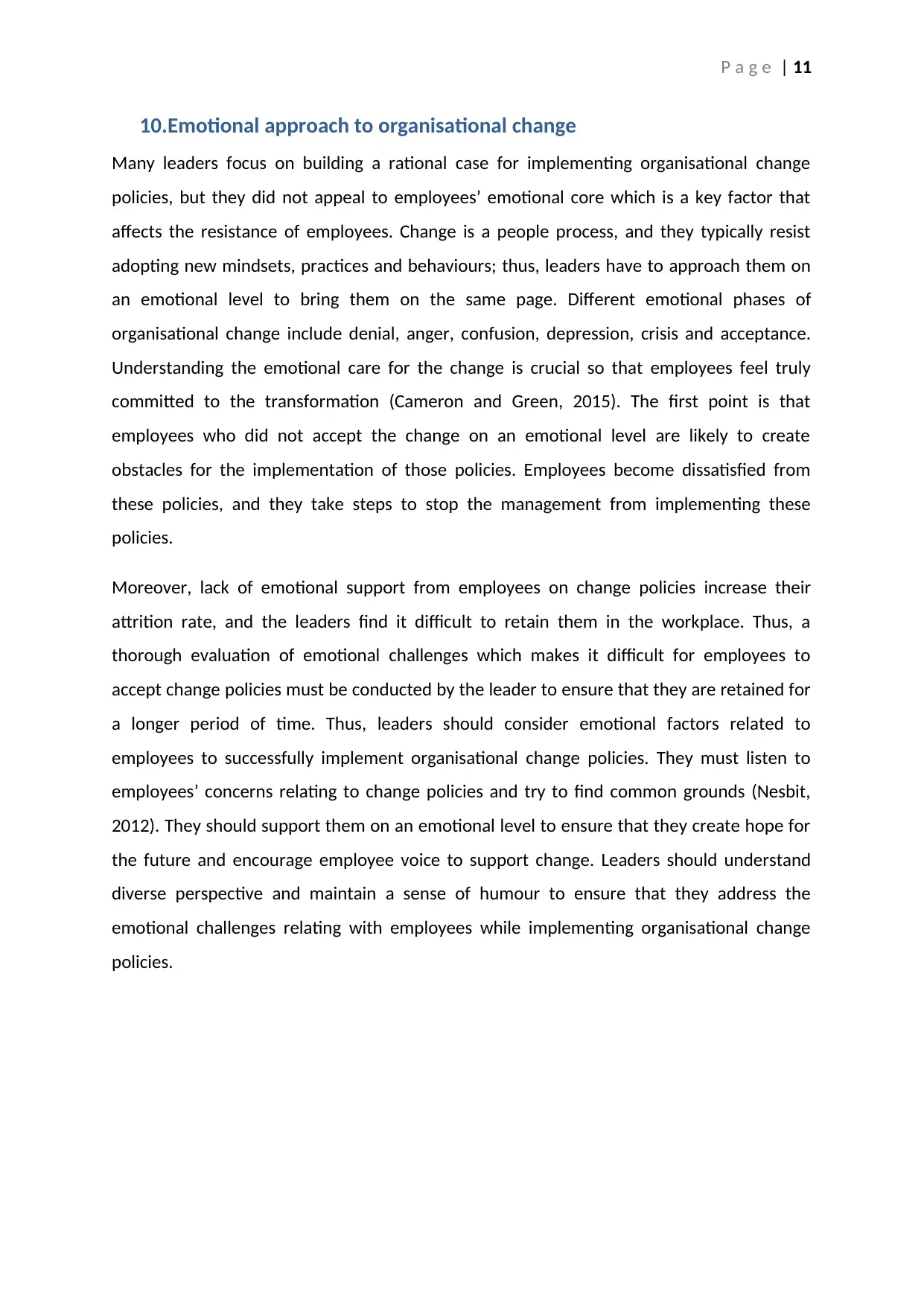
P a g e | 11
10.Emotional approach to organisational change
Many leaders focus on building a rational case for implementing organisational change
policies, but they did not appeal to employees’ emotional core which is a key factor that
affects the resistance of employees. Change is a people process, and they typically resist
adopting new mindsets, practices and behaviours; thus, leaders have to approach them on
an emotional level to bring them on the same page. Different emotional phases of
organisational change include denial, anger, confusion, depression, crisis and acceptance.
Understanding the emotional care for the change is crucial so that employees feel truly
committed to the transformation (Cameron and Green, 2015). The first point is that
employees who did not accept the change on an emotional level are likely to create
obstacles for the implementation of those policies. Employees become dissatisfied from
these policies, and they take steps to stop the management from implementing these
policies.
Moreover, lack of emotional support from employees on change policies increase their
attrition rate, and the leaders find it difficult to retain them in the workplace. Thus, a
thorough evaluation of emotional challenges which makes it difficult for employees to
accept change policies must be conducted by the leader to ensure that they are retained for
a longer period of time. Thus, leaders should consider emotional factors related to
employees to successfully implement organisational change policies. They must listen to
employees’ concerns relating to change policies and try to find common grounds (Nesbit,
2012). They should support them on an emotional level to ensure that they create hope for
the future and encourage employee voice to support change. Leaders should understand
diverse perspective and maintain a sense of humour to ensure that they address the
emotional challenges relating with employees while implementing organisational change
policies.
10.Emotional approach to organisational change
Many leaders focus on building a rational case for implementing organisational change
policies, but they did not appeal to employees’ emotional core which is a key factor that
affects the resistance of employees. Change is a people process, and they typically resist
adopting new mindsets, practices and behaviours; thus, leaders have to approach them on
an emotional level to bring them on the same page. Different emotional phases of
organisational change include denial, anger, confusion, depression, crisis and acceptance.
Understanding the emotional care for the change is crucial so that employees feel truly
committed to the transformation (Cameron and Green, 2015). The first point is that
employees who did not accept the change on an emotional level are likely to create
obstacles for the implementation of those policies. Employees become dissatisfied from
these policies, and they take steps to stop the management from implementing these
policies.
Moreover, lack of emotional support from employees on change policies increase their
attrition rate, and the leaders find it difficult to retain them in the workplace. Thus, a
thorough evaluation of emotional challenges which makes it difficult for employees to
accept change policies must be conducted by the leader to ensure that they are retained for
a longer period of time. Thus, leaders should consider emotional factors related to
employees to successfully implement organisational change policies. They must listen to
employees’ concerns relating to change policies and try to find common grounds (Nesbit,
2012). They should support them on an emotional level to ensure that they create hope for
the future and encourage employee voice to support change. Leaders should understand
diverse perspective and maintain a sense of humour to ensure that they address the
emotional challenges relating with employees while implementing organisational change
policies.
⊘ This is a preview!⊘
Do you want full access?
Subscribe today to unlock all pages.

Trusted by 1+ million students worldwide
1 out of 16
Related Documents
Your All-in-One AI-Powered Toolkit for Academic Success.
+13062052269
info@desklib.com
Available 24*7 on WhatsApp / Email
![[object Object]](/_next/static/media/star-bottom.7253800d.svg)
Unlock your academic potential
Copyright © 2020–2025 A2Z Services. All Rights Reserved. Developed and managed by ZUCOL.





